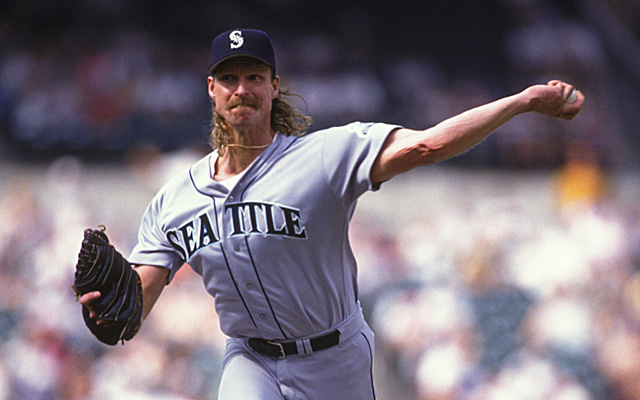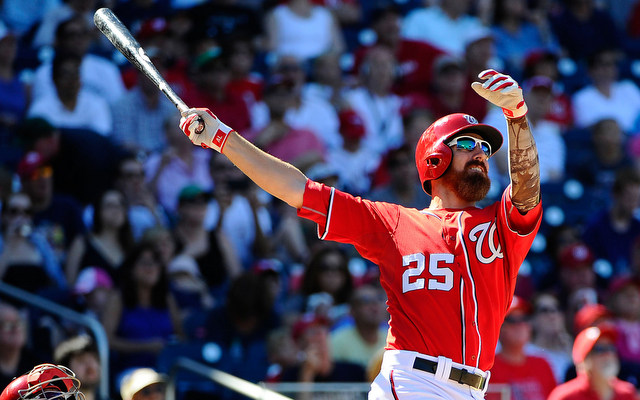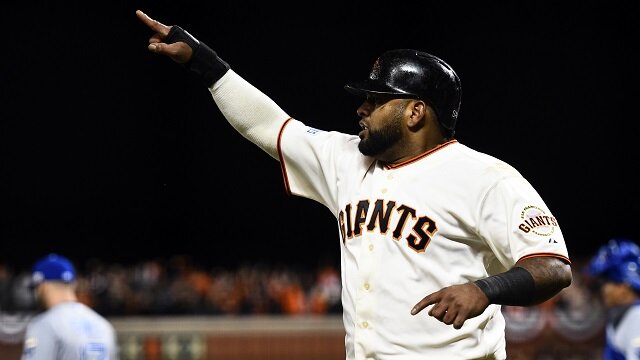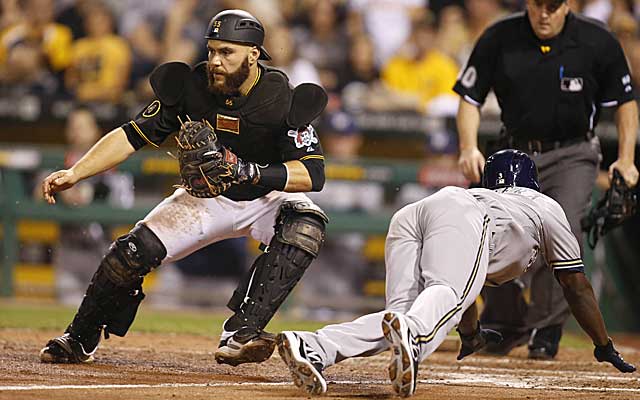 |
| Johnson's at the top of his Hall of Fame class (CBSSports) |
The 2015 Hall of Fame ballot was released last week, adding 17 new names to what is already an overcrowded BBWAA ballot. In addition to the three pitchers everyone thinks are Hall-worthy, I also view a hitter as Cooperstown-caliber. Here are my thoughts on the star-studded first-timers.
Hall of Famers
Randy Johnson
Like
Greg Maddux last year, Johnson is a slam-dunk, no-doubt Hall of Famer. Let's start with the five
Cy Young awards--more than anyone not named
Roger Clemens--including four consecutively from 1999-2002 (he also finished runner-up three times and third once). There's also the 4,875 strikeouts, second only to
Nolan Ryan (but most by a lefty), and nine strikeout titles. The ten-time All-Star is the record-holder for starting pitchers in career and single season K/9 marks, with 10.6 and 13.4 (in 2001), respectively. One of the most dominant pitchers ever, Johnson hurled two no-hitters (including a perfect game), struck out 20 batters in a game, pitched an immaculate inning (three strikeouts on nine pitches), and was co-World Series MVP in 2001 with
Curt Schilling. Incredibly durable, Johnson pitched until he was 46, sustaining a 3.29 ERA (135 ERA+) and compiling 111.7 fWAR over more than 4,000 innings. Lastly, the Big Unit won 303 games in his 22-year career, which should placate the old-school voters who still think 300 wins is a requisite for any starting pitcher to make the Hall.
Pedro Martinez
The only knock against Martinez is that he wasn't very durable (only two seasons with more than 217 innings), but that didn't stop him from accumulating 87.1 fWAR over his 18-year career. The best pitcher in baseball from
1997 through 2003, Pedro sustained the prime dominance of
Sandy Koufax (five major league ERA titles, each time with an ERA+ above 200) but surrounded it with more good seasons, earning All-Star nods in eight of them. Peak Pedro (1999-2000) pitched better than anyone else in baseball history given what he did while pitching half his games at Fenway during the height of the steroid era. He deserved the 1999 AL MVP award over
Ivan Rodriguez and won three Cy Youngs, finishing in the top-four four other times. Had a career 2.93 ERA (154 ERA+, best in history for s starter), 1.05 WHIP (the lowest of any live-ball era starting pitchers, 4.15 K/BB ratio (third-highest in MLB history), and the second-best winning percentage (.687 at 219-100) ever. He also helped the Boston Red Sox end their 86-year World Series drought. If that's not a Hall of Famer, I don't know what is.
John Smoltz
With 78.7 fWAR and over 3,000 strikeouts, Smoltz is clearly a Hall of Famer: the only question is whether he's a first-ballot Hall of Famer like rotation-mates Maddux and
Tom Glavine. My guess is that the writers will say no because his candidacy is awfully similar to Curt Schilling's, and Schilling didn't come close to getting elected in either of his first two years on the ballot. Voters are also likely to ding him because of the four seasons he spent as a closer (although he was a phenomenal closer) and the one year he missed entirely due to injury in the heart of his 30s. Even so, the eight-time All-Star and 1996 NL Cy Young winner deserves to go in this year, if only to help clear the logjam of viable candidates. Voters might frown on his 213 career wins and one 20-win season, even though he had 10 with at least 14 victories. More importantly, he maintained a 3.33 ERA (125 ERA+), 3.24 FIP, 1.18 WHIP, and 3.05 K/BB ratio over nearly 3,500 innings, the bulk of which came during the steroid era. The 1992 NLCS MVP also deserves a bump for his exceptional postseason record, which includes 15 wins and a 2.67 ERA in 209 October innings.
Gary Sheffield
Putting aside his PED associations and relatively modest WAR total (60.2 according to B-R, right on the borderline of Hall-worthy), Sheffield seems like a pretty clear Hall of Famer to me. Over the meat of his career from 1992 to 2005, when he made nine All-Star teams, won five Silver Sluggers, and earned six top-10 MVP finishes, he produced more offensive value
than all but two guys;
Barry Bonds and
Jeff Bagwell, both of whom should have been inducted already. He topped 30 homers and 100 RBI eight times each during that span, exceeding a 1.000 OPS five times while batting .304/.411/.551 (153 wRC+). For his career he smacked 509 homers, scored and knocked in more than 1,600 runs, stole 253 bases, walked 304 times more than he whiffed, piled up nearly 2,700 hits, and posted a .907 OPS. He's in the top-40 all-time in oWAR, runs, homers, RBI, total bases, walks, runs created, times on base, and extra base hits. What's more, he's comfortably worthy based on the Hall of Fame monitor, Hall of Fame standards, and
Hall of Stats. I hated Sheffield during his playing days, but the guy could flat-out mash. He was like a poor man's
Manny Ramirez.
On the Fence:
Carlos Delgado
From 1996 though 2008, only five men
hit more home runs than Delgado, who slugged 457 of his 473 career dingers. Just two--
Alex Rodriguez and Manny Ramirez--drove in more runs. A feared hitter for many years, Delgado managed at least 138 games played, 24 home runs, and 87 RBI every year during that span, consistency reminiscent of
Eddie Murray. He is one of only six men in baseball history to hit at least 30 home runs in ten consecutive seasons, something he accomplished from 1997 through 2006 (he also went yard 38 times in 2008, giving him 11 30-homer seasons overall). Delgado's career included a tremendous six-year stretch from 1998 through 2003 in which he exceeded 30 doubles, 30 homers, 100 RBI, and a .948 OPS every year. He won all three of his Silver Sluggers during that span, each one coinciding with a 40-homer season. Delgado remained productive to the very end, and were it not for a trio of hip surgeries cutting short his career he likely would have reached 500 home runs and doubles for his career. Delgado's definitely a borderline case at best (his candidacy is very similar to
Jim Rice's) and he shouldn't go in on the first ballot, or possibly even the writer's ballot, but I think he should be inducted eventually for sustaining such a high level of production for such a long time. His 138 OPS+ is very strong and he's in the top-50 all-time in home runs, at-bats per homer, slugging, OPS, extra base hits, and falls just outside in RBI. He's also the all-time leader in home runs and RBI for Puerto Rican born players, something I give a lot of consideration to in that he was an exemplary ambassador of the game.
Troy Percival
Percival was a very good closer in his decade with the Angels, but wasn't dominant enough and didn't do it long enough to get my vote. His 3.87 FIP indicates he wasn't nearly as sharp as his 3.17 career ERA (146 ERA+) and 1.11 WHIP suggest, and he just wasn't the same guy after leaving the Angels (2.99 ERA with Anaheim, 4.06 ERA in the four seasons afterwards). Only had five seasons with an ERA below 3.45, which isn't that impressive for a closer pitching half his games in a friendly home park. His 358 saves are impressive (ninth-most all-time), and he was in his league's top-10 nine straight seasons from 1996 through 2004 (when only
Trevor Hoffman and
Mariano Rivera had more saves) and again in 2008, but saves aren't a good measure of a pitcher's skill. I think it's more telling that he wasn't able to thrive away from Anaheim's strong defenses and pitcher-friendly park. That said, closers are underrepresented in the Hall and Percival was definitely a good one, so I could see him going in someday.
We're Not Worthy:
Rich Aurilia
Aurilia was a solid shortstop in the first half of the 2000s, but didn't do nearly enough in his 15-year career to merit induction. Like Erstad,
had one really great season (2001) surrounded by a couple decent ones.
Aaron Boone
Made an All-Star team and hit one of the
most memorable home runs in baseball history, but overall his career was pretty mediocre. He was never the same after shredding his knee while playing pick-up basketball during the 2003-2004 offseason, an injury that led the New York Yankees to acquire then-shortstop Alex Rodriguez to replace him at the hot corner.
Tony Clark
Clark enjoyed a great start to his career with 127 home runs, 402 RBI, and an .855 OPS through his first five seasons, but injuries suppressed his counting numbers throughout the remainder of his playing days. He never exceeded 130 games played in a season after his age-27 season and averaged only 104 per year in his 15-year career. Was a great slugger when healthy with four 30-homer seasons and another with 27, even posting a 1.003 OPS at age 33 in 2005, but his career numbers are about half of what a first baseman from the last quarter century needs to make the Hall.
Jermaine Dye
A steady source of power, Dye was one of the more consistent players in baseball throughout the 2000s. Excusing his injury-shortened 2003 in which he played just 65 games, Dye blasted at least 23 home runs every year from 1999 through 2009--his final big league season--with at least 78 RBI and a 102 OPS+ each year. The two-time All-Star finished fifth in the 2006 AL MVP vote with a career-high 44 home runs, 120 RBI, and 1.006 OPS, the only time he ever finished in the top-10 (he finished 15th two years later), and won his only Silver Slugger that year as well. Never a great baserunner or defender (his lone Gold Glove aside), Dye finished his career with only 20.3 bWAR despite slamming 325 home runs and driving in 1,072 runs with an .826 OPS. Dye
involuntary retired following a 2009 campaign in which he still showed plenty of thump in his bat, as he was unable to find a contract to his liking after smacking 27 home runs and posting a .340 OBP the year before.
Darin Erstad
Like Garciaparra, Erstad was a fine player who played from 1996 to 2009, peaked in the late 1990s and early 2000s, but really didn't do much in his last handful of seasons. Nothing special offensively outside of his
Mike Trout-esque 2000 (93 career wRC+), Erstad supplemented his mediocre bat with decent speed (179 steals against 58 caught stealing) and terrific defense in center field, where he won a trio of Gold Gloves. The two-time All-Star might have had a chance at the Hall had he remained productive throughout his 30s, but had his last good year at 31 and played his last game at 35.
Cliff Floyd
Floyd was a solidly above average hitter for the majority of his 17-year career (118 wRC+), but his attendance was astoundingly poor: in only five of those years did he even play 120 games. Accordingly, his counting numbers are pretty weak (fewer than 1,500 hits and 900 runs/RBI). That said, we shouldn't overlook the fact that a healthy Floyd was a very good ballplayer--a 20/20 threat (something he did twice) capable of batting .300 with good on-base percentages. He just didn't show up often enough.
Nomar Garciaparra
Like
Don Mattingly and
Tony Oliva, Garciaparra had a
Hall of Fame peak (just look at his 162 game averages) but not a Hall of Fame career. The two-time batting champion had seven seasons with at least 20 home runs, 90 RBI, and a .300 batting average, racking up 43 bWAR in those years (an average of 6.1 per season). In his other seven seasons, however, he was worth only 1.2 bWAR
combined. The 1998 AL MVP runner-up was practically irrelevant after turning 30, but before that
he was ahead of Derek Jeter and not far behind A-Rod.
Brian Giles
One of the more underrated players of the past two decades, Giles was a tremendous on-base threat (career .400 OBP) with good power (.211 ISO). I was shocked to see he was worth 50.9 bWAR in his 15-year career, an average of 3.9 per 600 plate appearances. The two-time All-Star had a sensational four-year run from 1999 through 2002, swatting at least 35 home runs every year while batting .309/.426/.604 (158 wRC+), ranking as the
sixth-most valuable position player in baseball during that span but never finishing higher than 13th in the MVP voting (so it goes when you play for losing Pirates teams while Barry Bonds,
Sammy Sosa, and
Mark McGwire are doubling your home run totals). Giles had several more good years after that, remaining productive through his age 37 season, but still ended up with less than stellar career totals because he didn't reach 400 plate appearances in a season until he was 28 (similar to
David Ortiz in that he got a late start but was a great hitter deep into his 30s). While his .902 career OPS (136 wRC+) is impressive, he falls considerably short in counting numbers and overall career value. Reminds me of
Ryan Klesko's case from a few years ago.
Tom Gordon
I couldn't believe Flash lasted 21 years in the big leagues and made three All-Star teams. While he was effective as both a starter and reliever, he wasn't dominant enough in either role to merit induction. He was like a homeless man's Smoltz or
Dennis Eckersley in this regard. Little more than 2,100 innings with a 3.96 ERA (113 ERA+), 1.36 WHIP, and 1.97 K/BB ratio doesn't cut it.
Eddie Guardado
Had a nice run in the early-to-mid-2000s with the Twins and Mariners, but the rest of his 17-year career was largely mediocre (46-61 with 4.31 ERA and 1.32 WHIP).
Jason Schmidt
Schmidt had a few dominant seasons with back-to-back top-five NL Cy Young finishes in 2003 and 2004 but was only intermittently effective in his 14-year career. In short, his 130 wins, 3.96 ERA (110 ERA+), 1.32 WHIP and 31.7 bWAR in fewer than 2,000 innings aren't good enough.













